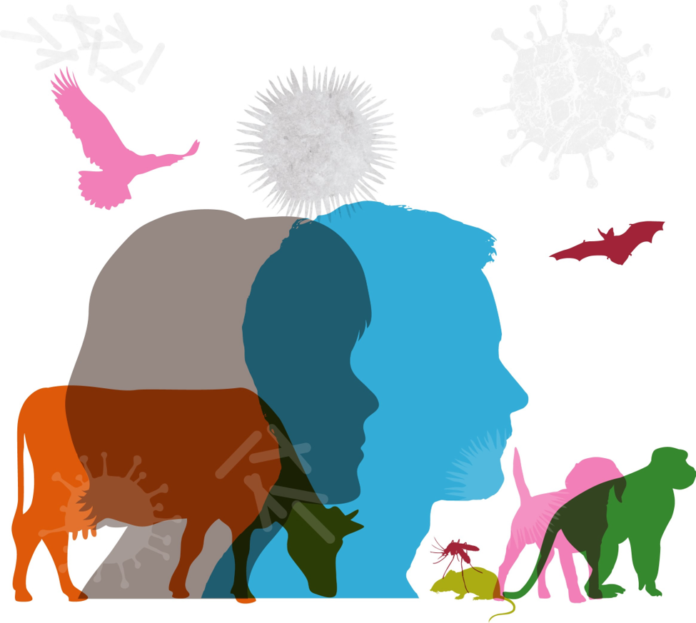One World, One Health: Preventing Zoonoses
Abstract
Zoonoses, diseases transmitted from animals to humans, pose significant threats to global public health. The concept of “One World, One Health” emphasizes the interconnectedness of human, animal, and environmental health, highlighting the need for collaborative efforts to prevent and control zoonotic diseases. This article explores the importance of preventing zoonoses, identifies contributing factors to their emergence, and outlines strategies to protect the health of humans and animals. By adopting a One Health approach and implementing surveillance systems, wildlife conservation measures, improved hygiene and food safety practices, and cross-sector collaboration, we can strive to create a world where the risks of zoonotic diseases are minimized, fostering a healthier and more sustainable future.
Introduction
In an interconnected world, the health of humans, animals, and the environment is intricately linked. Zoonoses, diseases that can be transmitted from animals to humans, have emerged as a significant global concern. The concept of “One World, One Health” recognizes the interdependence of human, animal, and environmental health, emphasizing the need for a collaborative approach to prevent and control zoonotic diseases. In this article, we will explore the importance of preventing zoonoses, the factors contributing to their emergence, and the strategies to protect the health of both humans and animals.
- Understanding Zoonoses:
Zoonoses are infectious diseases caused by bacteria, viruses, parasites, or fungi that can be transmitted between animals and humans. They can range from mild illnesses to severe and potentially fatal conditions. Examples of well-known zoonotic diseases include rabies, Ebola, influenza, and COVID-19. Understanding the nature of zoonoses is crucial to appreciate their impact on public health and the importance of prevention and control efforts.
- Factors Contributing to The emergence and spread of zoonotic diseases Emergence:
The emergence and spread of zoonotic diseases are influenced by various factors. We will delve into the factors contributing to their emergence, including habitat destruction, wildlife trade, intensification of agriculture, climate change, and increased human-animal interactions. Exploring each of these factors will help us understand the complex dynamics that facilitate the transmission of zoonoses from animals to humans.
- The Importance of One Health Approach:
The One Health approach recognizes that the health of humans, animals, and ecosystems are interconnected. By adopting a holistic perspective, One Health advocates for collaboration and integration across disciplines, including human medicine, veterinary medicine, environmental science, and public health. This section will emphasize the significance of adopting a comprehensive and interdisciplinary approach to prevent and control zoonotic diseases.
- Strategies for Preventing Zoonoses:
This section will discuss various strategies for preventing zoonotic diseases and safeguarding public health. Each strategy will be examined in detail:
- Surveillance and Early Detection: Timely surveillance systems that monitor animal and human populations for disease outbreaks are crucial for early detection. We will explore the importance of surveillance and how it can aid in rapid response efforts.
- Wildlife Conservation and Habitat Preservation:W Protecting natural habitats and biodiversity is essential in reducing human-wildlife interactions and the potential for disease transmission. We will discuss the role of wildlife conservation in preventing zoonoses.
- Strengthening Animal Health Systems: Robust veterinary services are pivotal in preventing and controlling zoonotic diseases. Ensuring access to quality veterinary care, promoting vaccination programs, and implementing proper livestock management practices will be examined in this section.
- Improved Hygiene and Food Safety: Promoting good hygiene practices, such as handwashing, safe food handling, and proper sanitation measures, is crucial in preventing zoonotic infections. We will explore the importance of hygiene and food safety in reducing the risk of zoonotic diseases.
- Cross-Sector Collaboration: Collaboration among public health agencies, veterinary services, environmental organizations, and research institutions is vital for sharing knowledge, expertise, and resources. We will discuss the significance of cross-sector collaboration in developing integrated strategies to prevent, detect, and respond to zoonotic disease outbreaks.
Conclusion:
The prevention of zoonoses requires a comprehensive and collaborative approach. By implementing strategies such as surveillance, wildlife conservation, strengthening animal health systems, promoting hygiene and food safety, and fostering cross-sector collaboration, we can strive towards a world where the risks of zoonotic diseases are minimized, and the health of all living beings is safeguarded. Embracing the philosophy of “One World, One Health” is not only a moral imperative but a strategic investment in the well-being of our planet and future generations. Through concerted efforts, we can create a healthier and more resilient world, where the harmony between humans, animals, and the environment thrives.
References:
- World Health Organization. (2020). Zoonoses. Retrieved from https://www.who.int/topics/zoonoses/en/
- Centers for Disease Control and Prevention. (2021). Zoonotic Diseases. Retrieved from https://www.cdc.gov/onehealth/basics/zoonotic-diseases.html
- United Nations Environment Programme. (2021). Zoonotic diseases: a guide to establish multisectoral coordination for prevention and control. Retrieved from https://www.unep.org/resources/report/zoonotic-diseases-guide-establish-multisectoral-coordination-prevention-and-control
- World Organisation for Animal Health. (2020). One Health. Retrieved from https://www.oie.int/en/what-we-do/one-health/
- Morse, S. S. (2020). Factors in the Emergence of Infectious Diseases. Emerging Infectious Diseases, 1(1), 7-15. doi:10.3201/eid0101.950102
Abbreviations:
- WHO – World Health Organization
- CDC – Centers for Disease Control and Prevention
- UNEP – United Nations Environment Programme
- OIE – World Organisation for Animal Health

Charu Singh- 4th year B.V.Sc&A.H
ANDUAT, Kumarganj, Ayodhya (U.P.)


